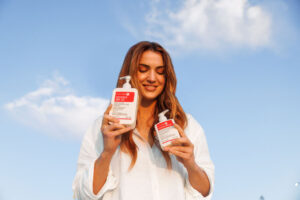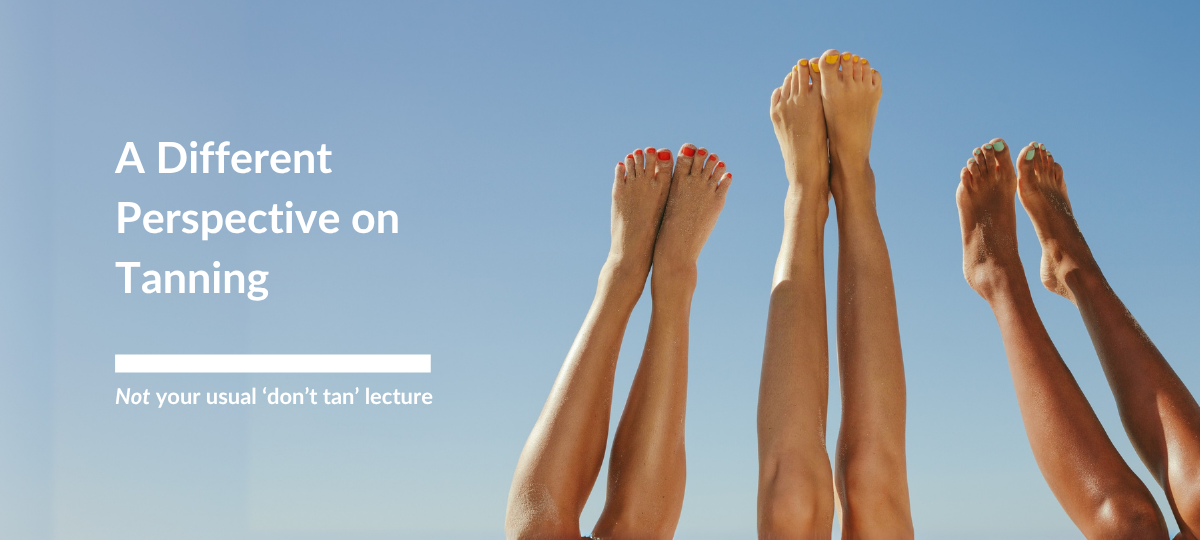Born in the 80s and raised in 90s Australia, I grew up golden. Long before I became a PR and marketing manager here at Bernier Pharmaceuticals — where we specialise in sun-damage education — tanning was just part of life. My mum smelled like coconut oil in summer while us kids ran under sprinklers, comparing tan lines and marvelling at how fast our skin changed colour. I loved seeing my fair skin turn a deeper olive tone while freckles scattered across my nose — an odd little combo from heritage. Irish in winter, Italian in summer, I used to joke.
Even in dance pageant culture, we were made to fake-tan over our real tans. Always chasing the “right” shade of bronze. And we justified it.
“It’s natural.”
“Our skin adapts.”
“A healthy tan is a healthy glow.”
But is that really the case?
We’ve all heard the warnings: “a tan is just skin damage in disguise.” And yes, that’s true. But this isn’t the same old “tanning is bad” spiel. What matters is why people still believe tanning makes sense — the cultural, biological, and evolutionary arguments we use to justify it. That’s what we’re going to dismantle.
Is Tanning Bad for Your Skin? (The Short Answer: Yes)
A tan isn’t your body “getting healthy.” It’s your skin responding to injury. That golden-brown colour people chase is literally your cells scrambling to protect themselves from UV damage.
And even then — that “natural” tan only gives SPF 3–4. Nowhere near enough to stop cumulative damage or prevent cancer.
So yes, tanning is natural. But natural doesn’t mean safe.
The Science of Skin Colour and Evolution
About 250,000 years ago in Africa, people evolved under constant, harsh UV. Melanin — the pigment in our skin — became a balancing act. Enough to buffer UV. But still let in sunlight to make vitamin D. Protect folate. Reduce DNA damage. Survival, not aesthetics.
As people migrated north and south, UV dropped off. Skin lightened to keep vitamin D levels up. That’s why populations closer to the poles evolved lighter skin.
So yes — tanning is natural. But here’s the nuance: evolution only needed to protect us long enough to reproduce. Into our 20s. 30s. Maybe 40s. After that, natural selection’s job was done.
And conveniently, that’s about how long most people lived until recently. There was no evolutionary pressure to protect us beyond that point.
Fast-forward to today. Our lifespans have doubled. We’re living long enough to see the limits of this balancing act. Evolution is not stepping in because there’s no pressure for it to. But science can — with sunscreen, shade, and ingredients like niacinamide.
Why Tanning Doesn’t Protect You From Skin Damage
Even if you tan easily, that colour is proof of injury. DNA damage building under the surface. Pigmentation, wrinkles, cancers waiting to surface.
And this isn’t only a “fair skin” issue. Darker skin tones get damage too — usually later in life. Melanin buffers some UV, but not all.
In Australia, fair skin can show damage by the 20s. Darker skin tones later. But as everyone ages, the gap narrows. No skin tone is immune.
Modern travel makes this mismatch even clearer. For most of human history, people lived and adapted within one region. Nomadic groups moved seasonally, but usually within a familiar climate — not across extreme UV zones. Migration did happen, but it was gradual, over generations, giving skin time to adapt.
Today, that’s changed. You can grow up in Australia, ski in Canada, and holiday in Mexico — all in the same year. Our skin simply can’t adjust that quickly.
So we can’t justify tanning with biology. That means the real push come from culture. From fashion. From trends.
Skin Tone, Power, and Perception
Beauty standards around skin tone have flipped constantly — almost always tied to culture, power, or profit.
In Victorian England, pale skin was prized. It proved you could afford to stay indoors.
In the 1920s, Coco Chanel came back from a yacht sunburnt. Suddenly bronzed skin was the new luxury.
By the 60s and 70s, tanning culture exploded. Solariums and sunbeds dominated the 90s and 2000s — until the evidence of harm was overwhelming, and Australia banned them.
The rest of the world and throughout history, it has also been different. Much of Asia has long favoured lighter skin — whitening creams are still sold widely today — while in ancient Nubia, dark skin was celebrated. Their art proudly depicts it. Fast forward, and darker tones have been marginalised. Colonial influence privileged lighter complexions.
A recent example of trends flipping is the Duchess of Sussex, Meghan Markle. Labelled “too dark.” Admired in other circles. Then suddenly praised for her freckles — freckles which, at their core, are melanin spots — just as fake freckles became a fad.
It’s exhausting. And abundantly clear: skin-tone ideals aren’t timeless truths. They’re manufactured. Reinforced. Flipped to suit the moment.
So where does that leave everyone who doesn’t fit the current trend?
Why the “Healthy Glow” Is a Dangerous Myth
Tanning isn’t timeless. It isn’t healthy. It’s DNA damage rebranded as beauty.
And if beauty standards keep flipping, maybe the healthiest thing we can do is stop chasing them.
Magazines will always decide what’s “in.” But not every colour works for every skin tone — and that’s fine. Just like some people shine in gold jewellery and others in silver, or how certain makeup tones bring your face to life while others wash it out, the same goes for your natural skin.
Fashion should adapt to your skin, not the other way around.
That, to me, is the real “healthy glow.” Not DNA damage. But confidence. Wearing your skin — and your colours — with pride.
How to Protect and Love Your Skin Instead of Tanning
Evolution gave us clever tools. But not for today’s lifespans, travel, or beauty pressures.
That’s why protection matters. Not because your skin is weak — but because it deserves care.
At SolarCareB3, that’s what we’re about. Skin health, not trends. Our products use clinical doses of niacinamide (Vitamin B3) to counter UV immune suppression, reduce blotchy pigmentation, and support skin integrity.
Pair that with broad-spectrum SPF — like our Defence SPF 50, which combines sun protection with 5% niacinamide — and you’ve got a routine that works with your biology, not against it.

SolarCareB3 FAQ
What is SolarCareB3?
A skincare line developed by Australian doctors and pharmacists for sun-damaged skin. Our products use clinical doses of niacinamide (Vitamin B3) in large bottles for daily, all-over use.
What does niacinamide do?
It helps counter immune suppression from UV and reduces the excess melanin that causes blotchy pigmentation.
Does SolarCareB3 have sunscreen?
Yes. Defence SPF 50 combines broad-spectrum sun protection with 5% niacinamide. It prevents sunburn today while supporting already sun-damaged skin.
What’s a simple SolarCareB3 routine?
- Morning: Defence SPF 50 (hydration, protection, support in one).
- Night: A SolarCareB3 moisturiser (5% for everyday use, 10% for more intensive care).
Is SolarCareB3 just for the face?
No. Skin doesn’t stop at the jawline. Neither does sun damage. That’s why we sell big bottles. Try the Daily Duo (500 ml Moisturiser + 400 ml Defence SPF 50) for head-to-toe care.
